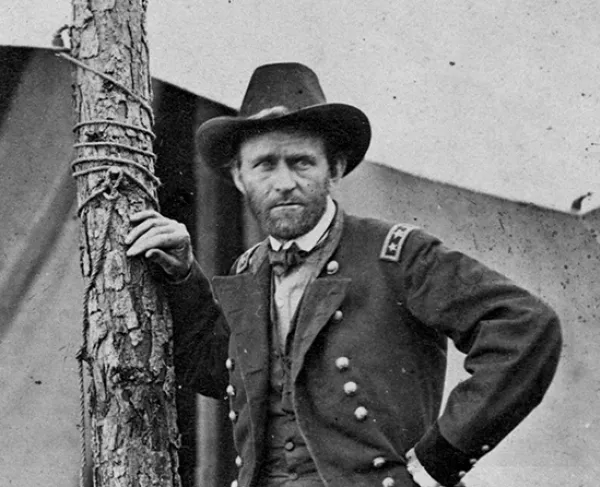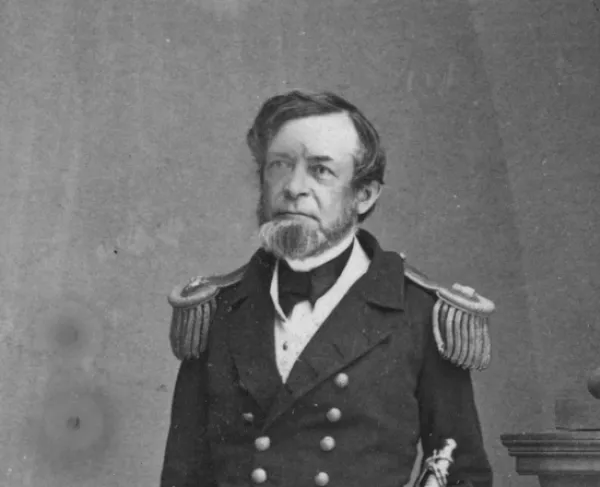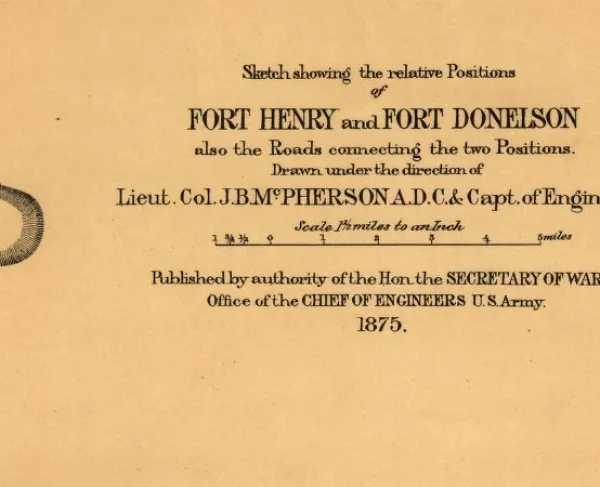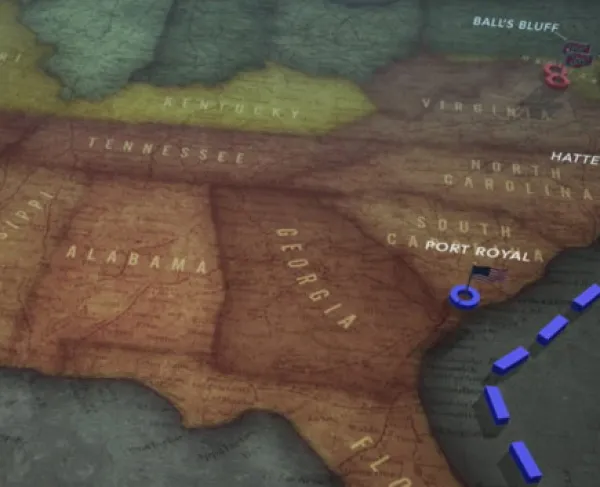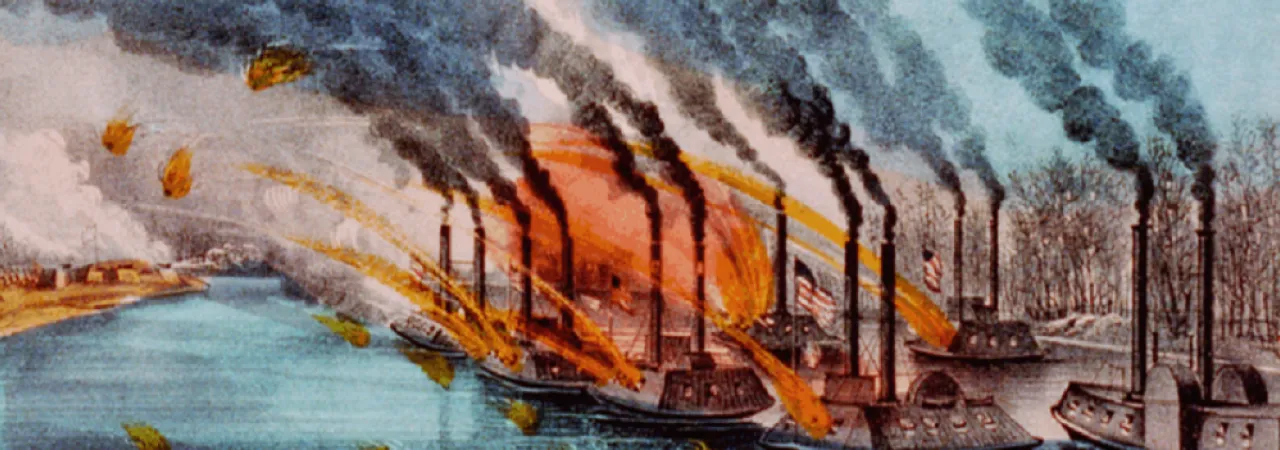
Fort Henry
Tennessee | Feb 6, 1862
The Battle of Fort Henry, Tennessee occurred as part of a Union plan to open a water route into the Confederate heartland by capturing Forts Henry and Donelson. In January of 1862, Brig. Gen. Ulysses S. Grant and Flag Officer Andrew Foote were commissioned to lead a joint expedition to seize the twin forts.
How It Ended
Union Victory. With greater manpower and artillery, Foote and his ships wreaked havoc on Confederate defenses for two hours, inflicting casualties and destroying their artillery. When Confederate Brig. Gen. Lloyd Tilghman asked Foote for the terms of surrender, the sailor’s response presaged Grant’s 10 days later at Fort Donelson: “Your surrender will be unconditional.”
In Context
Gen. Albert Sidney Johnston was charged with the defense of the Confederate border between the north and south in the Western Theater. To the Union’s advantage, Johnston had roughly only 71,000 Confederate soldiers and a cadre of unimpressive subordinates to employ for the defense of key strategic positions. In Tennessee, Fort Henry was badly situated on a low bank of the Tennessee River and represented the weakest point in Johnston's defensive line in the Western Theater in early 1862. Seeking to open river traffic on the Tennessee and Cumberland rivers, Federals targeted Fort Henry on the Tennessee River. Capturing Fort Henry and its sister, Fort Donelson, some five miles distant, would split Johnston’s defensive line in two while opening the rivers to the Federals.
On January 30, 1862, Brig. Gen. Ulysses Grant received the long-anticipated word that he and Flag Officer Andrew Foote would lead a joint expedition against the twin forts of Fort Henry and Fort Donelson.
On February 2, 1862, Brig. Gen. Ulysses S. Grant and Flag Officer Andrew Foote moved a force of 15,000 soldiers, four ironclads, and three timberclad ships toward Fort Henry. Some 3,000 Confederates commanded by Brig. Gen. Lloyd Tilghman manned the defenses of Fort Henry. Spirits in the Union ranks were high, but the situation inside Fort Henry was vastly different. The Confederates under Tilghman were poorly armed — many of them with flintlock rifles dating from the War of 1812 — and the inclement weather had left many ill. Although Fort Henry’s walls were 20-feet high and 20-feet thick at the base, winter rains had swollen the river, leaving the parade ground submerged beneath two feet of water and much of the powder in the magazines damp.
On February 4–5, Grant’s infantry disembarked, out of range of Fort Henry’s guns. Upon learning of the size and composition of the Union force from scouts, Tilghman withdrew entirely from the incomplete walls of Fort Heiman, on the west bank of the river, and dispatched the majority of the force inside Fort Henry overland to the more defensible Fort Donelson. Still, he determined to make a stand against the coming gunboats rather than abandon Fort Henry to the enemy.
15,000
2,500
At noon on February 6, 1862, Foote ordered his flotilla into position less than 300 yards from the fort. Grant's infantry was to come up behind the rear of the fort while Foote's ships bombarded the fort from the river. The point-blank range battle wreaked havoc on the Confederates. Confederate cannoneers put up a fight against the flotilla of gunboats in the river, but it was not enough to deter the Union offense. Before long, all four of the fort’s heavy guns had been lost and 21 Southerners were casualties. A direct hit to the middle boiler knocked the ironclad USS Essex out of commission, causing 32 Union casualties in one shot and disabling her for the rest of the campaign. The Cincinnati took 32 hits, the St. Louis seven, and the Carondelet six. Confederates had the worst of it though, and Tilghman asked Foote for terms. The Union sailor’s response presaged Grant’s 10 days later at Fort Donelson: “Your surrender will be unconditional.” In a ceremony onboard the USS Cincinnati, 12 officers and 82 men surrendered. Grant’s infantry, slowed by muddy roads, arrived after the surrender.
42
21
When Grant’s infantry arrived a few hours later, they found a large quantity of provisions and six mobile cannons mired in the mud, evidence of the alacrity with which the last vestiges of the Confederate force had vacated the doomed position.
Despite the limited scope of the battle and subsequent casualties, the fall of Fort Henry opened the Upper Tennessee to the Union and set the stage for the fall of Fort Donelson roughly one week later. The combined victories at Forts Henry and Donelson propelled Grant into the national spotlight. Fort Henry was also one of the first major Union victories in the war and had a significant impact on Union morale in the bleak months following the rout at Bull Run and the defeat at Wilson's Creek.
With the Tennessee now open before him, Foote dispatched his three timberclads, Tyler, Conestoga and Lexington, as far as Muscle Shoals, Ala., destroying supplies and infrastructure as they went, even capturing the uncompleted Confederate ironclad Eastport. The raid’s critical flaw was sparing the railroad bridge at Florence, Ala., which would play a critical role in the Battle of Shiloh two months later.
As seen at the Battle of Fort Henry, the navy played an important role in the Civil War. After the firing on Fort Sumter on April 15, 1861, both the Union and the Confederacy began building both strong armies and navies. From the beginning, both sides knew the importance of controlling the waterways. Early in the war, strategies such as Winfield Scott’s Anaconda Plan called for naval deployment to blockade southern ports and gain control of the Mississippi River, which would split the Confederacy in two. However, moving these large ships required access to water. Throughout the war, the North and the South often fought over ports and cities with this access to the water. They battled at places such as Vicksburg, Mississippi in July 1863 for access to the Mississippi River, and Fort Fisher in in January 1865 for control of the eastern coastal stronghold near Wilmington, North Carolina. Access to the water allowed the navies to blockade, attack, and transport supplies throughout their region. The Union needed to gain access to the Tennessee and Cumberland Rivers in order to move their ships throughout Tennessee and beyond as part of the plan to defeat the Confederacy.
Typically, after one side secured victory in a battle, the commanders negotiated the terms of surrender, discussing formalities and prisoner exchanges. When Foote demanded an unconditional surrender at Fort Henry, he shattered the protocols of normal, gentlemanly surrender. Foote’s response may have resonated with Grant, who later became known as “Unconditional Surrender Grant” after he used the same tactic in future battles. In fact, when Grant secured victory at Fort Donelson shortly after Fort Henry, he used this strategy of calling for an unconditional surrender. This choice after such a crucial victory for the Union earned him the respective nickname. From then on, Northern newspapers used the nickname to reinforce Grant’s reputation as a stronghold of the Union army. However, Grant was not the only commander who called for unconditional surrenders throughout the war, and additionally, Grant himself did not always use the strategy. For example, when Robert E. Lee surrendered to Grant at Appomattox Courthouse on April 9, 1865, Grant allowed negotiations.
Regardless, Grant’s legacy as “Unconditional Surrender” made an indelible mark on the future of the United States. Even today, he is often referred to by the fond nickname that reminds Americans of his military prowess. Most notably, Franklin D. Roosevelt mirrored Grant’s tactical move during World War II when he said the objective of the war was to secure an unconditional surrender from the Axis powers.
Fort Henry: Featured Resources
All battles of the Federal Penetration up the Cumberland and Tennessee Rivers Campaign
Related Battles
15,000
2,500
42
21
